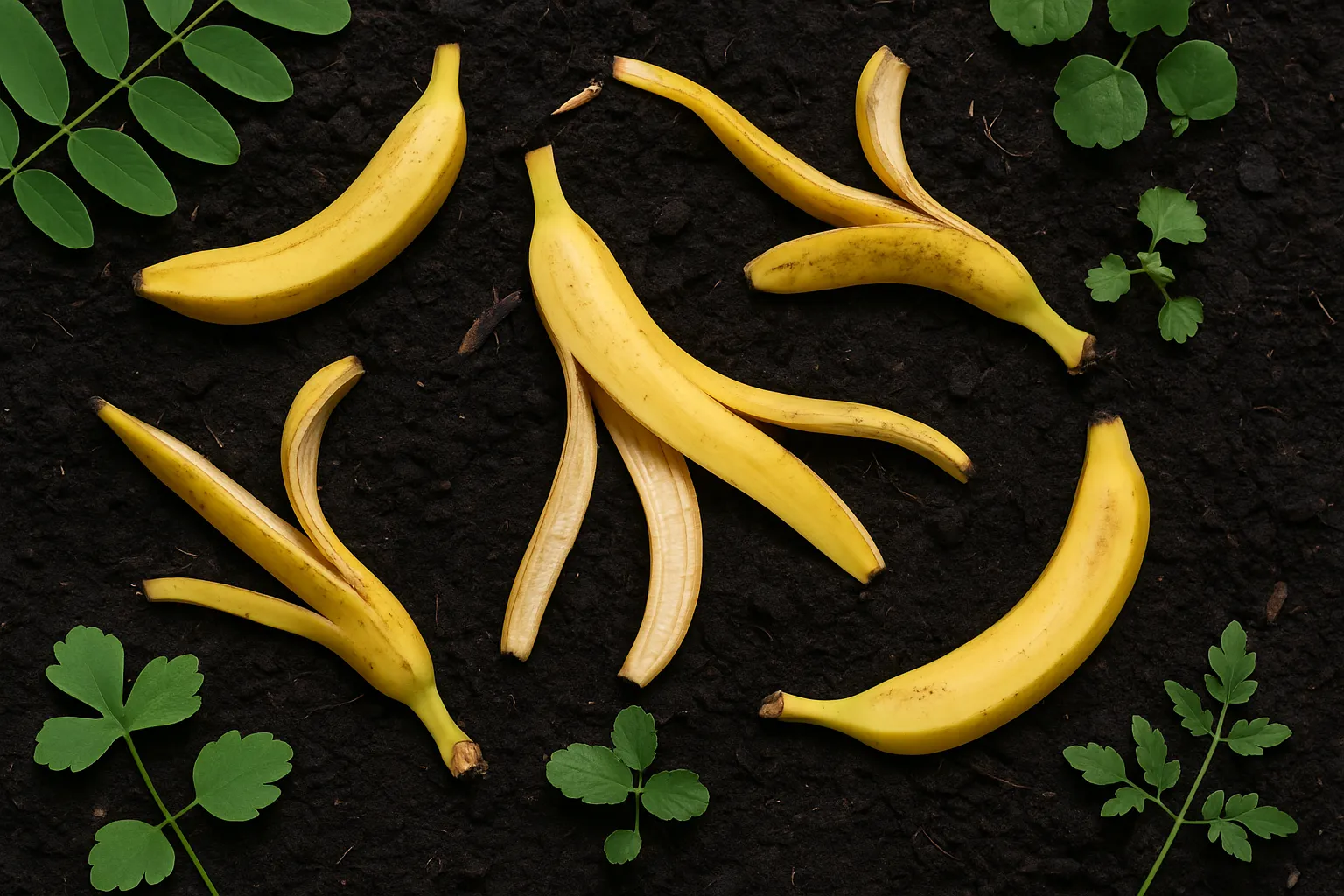Most people toss banana peels straight into the trash without realizing they’re packed with hidden benefits for the garden. Rich in potassium, phosphorus, calcium, and other essential nutrients, banana peels are a natural powerhouse for plant growth, flowering, and soil health. By reusing them in creative ways, you not only reduce kitchen waste but also save money on store-bought fertilizers and pest control products. Whether you’re tending to vegetable beds, flowering plants, fruit trees, or indoor pots, banana peels can make a noticeable difference in how your garden thrives. From boosting tomatoes and peppers to attracting pollinators and improving compost, these simple tricks can turn everyday scraps into valuable gardening tools.
1. Natural Fertilizer for Strong Growth
Banana peels are loaded with essential nutrients like potassium and phosphorus, which play a key role in strong root development and overall plant health. Because they decompose quickly, they release these nutrients into the soil almost immediately. The easiest way to use them is to chop the peels into small pieces and bury them near the roots of your plants. I’ve found that doing this in my tomato patch made the plants look greener and sturdier within a couple of weeks. If you’re growing heavy feeders like peppers or cucumbers, this little trick can make a noticeable difference in their growth without the need for chemical fertilizers.
2. Boost Flowering Plants
If you want your flowers to bloom brighter, last longer, and look healthier, banana peels can help make that happen. The potassium they contain directly supports flower and fruit production, giving your roses, hibiscus, or geraniums the nutrients they crave. Simply placing chopped banana peels around the base of flowering plants can give them a boost. I once tried this with my roses, and the number of blooms nearly doubled compared to the year before. For best results, repeat this every couple of weeks during the flowering season.
3. Compost Accelerator
Adding banana peels to your compost pile can really speed things up. Since they’re soft and full of moisture, they decompose faster than most kitchen scraps and help kick-start the breakdown process. The added nutrients enrich your compost, giving you a nutrient-dense mix for your garden beds. Whenever I make smoothies at home, I toss the peels straight into the compost bin, and it always seems like the pile heats up faster afterward. If you’ve struggled with slow composting, banana peels might be the missing ingredient to get things going.
4. Homemade Banana Peel Tea
Another clever way to use banana peels is by making a simple garden tea. All you need to do is soak the peels in a jar of water for two or three days, then strain the liquid and use it to water your plants. The result is a nutrient-rich “tea” that works like a natural multivitamin for your garden. I’ve used this on my potted herbs, and they perked up almost overnight. A tip: use this liquid within a few days to avoid any bad odor, and apply it to the soil rather than spraying it on the leaves for best results.
5. Natural Pest Repellent
One surprising benefit of banana peels is that they can help keep certain pests at bay, especially aphids. The scent and compounds in the peels act as a deterrent, making plants less attractive to these little invaders. To use this method, place chopped peels just under the soil surface around vulnerable plants. I’ve done this around my lettuce beds, and it made a huge difference in keeping the aphids from taking over. It’s not a complete replacement for other pest control methods, but it’s an easy, natural line of defense that works well in combination with other strategies.
6. Healthy Tomato Booster
Tomatoes are heavy feeders, and potassium is one of the nutrients they crave most. By placing strips of banana peels at the bottom of planting holes before adding your seedlings, you’re giving them a strong and nutrient-rich start. As the peels break down, they release potassium and phosphorus right where the young roots need it. I started doing this a few years ago with my tomato plants, and the difference was striking—they grew stronger stems and produced more fruit clusters compared to untreated plants. This trick is especially handy if you want to cut back on synthetic fertilizers but still want big, juicy harvests.
7. Shine Plant Leaves
Indoor plants can easily collect dust, which not only dulls their appearance but also blocks light from reaching the leaves. A quick, natural fix is to rub the inside of a banana peel directly onto the leaves. The soft, fleshy side of the peel removes dust while leaving behind a light, nutrient-rich residue that makes the leaves shine. I once tried this on my fiddle-leaf fig, which was looking a bit tired, and within minutes it looked like I had just polished it with a professional cleaner. Plus, it feels good knowing you’re feeding your plant a tiny bit at the same time.
8. Encourage Butterfly & Bird Visits
If you want to bring more life into your garden, banana peels can act as an irresistible invitation for butterflies and birds. Their natural sugars attract these creatures, turning your backyard into a lively little sanctuary. Just place small pieces of banana peel on a shallow dish or flat surface outdoors and watch as the visitors arrive. I’ve done this on summer mornings, and it’s incredible to see butterflies fluttering around while small birds stop by for a quick snack. It’s a simple way to add biodiversity to your garden while repurposing food scraps.
9. Root Growth Stimulant
A blended banana peel mixed with water creates an easy homemade root tonic. This liquid is packed with potassium, calcium, and magnesium—minerals that encourage strong and healthy root systems. Pouring it around new seedlings or transplants helps them settle in faster and withstand environmental stress. I’ve used this trick with my pepper seedlings, and they always bounce back quickly after transplanting. The blend is also a great option if you don’t have compost ready but want to give your plants a boost during the most crucial early growth stage.
10. DIY Soil Amendment
For a longer-lasting fertilizer, you can dry banana peels in the sun and then grind them into a fine powder. Sprinkling this powder over your soil works as a slow-release amendment, especially effective for container gardens and raised beds where nutrients wash out more quickly. I like to store a small jar of banana peel powder in my garden shed and use it whenever I pot up new plants. It’s convenient, mess-free, and ensures my soil stays nutrient-rich over time without constant re-application. This method is perfect if you prefer a more hands-off approach to fertilizing but still want consistently healthy plants.
11. Revive Tired Soil
Over time, soil in garden beds and pots can lose nutrients, leaving plants struggling to thrive. Mixing chopped banana peels into the soil helps restore organic matter and replenishes vital minerals like potassium, calcium, and magnesium. I once added a few handfuls of peel pieces into an old planter that hadn’t grown much in years, and within weeks, the herbs I planted there looked greener and fuller. It’s an easy, low-cost way to breathe new life into tired soil without relying on store-bought fertilizers.
12. Support Fruit Trees
Fruit trees, from apples to peaches, benefit tremendously from the slow release of nutrients found in banana peels. Simply bury a few peels around the base of the tree, making sure they’re a few inches under the soil to prevent pests. As the peels decompose, they feed the tree and improve soil health in the surrounding area. I’ve used this trick on my lemon tree, and not only did the foliage look healthier, but the fruits seemed juicier and more flavorful. It’s a natural way to give your trees a steady source of nourishment.
13. Seedling Starter Cups
Banana peels can serve as mini biodegradable containers for starting seeds. Just cut the peel into sections, fill them with a little soil, and plant your seeds inside. As the seedlings grow, you can transplant the peel and all directly into the garden, where it will continue to decompose and feed the plant. I tried this with bean seeds, and the transition from starter peel to garden soil was seamless. This approach not only recycles waste but also eliminates transplant shock, giving young plants the best possible start.
14. Attract Pollinators
Pollinators like bees and butterflies are essential for a thriving garden, and banana peels can help lure them in. Their natural sugars emit a scent that draws these helpful insects closer to your plants. Placing a few peel pieces near flowering crops encourages more visits, which means better pollination and higher yields. I remember setting out banana peels near my squash plants one season and noticing a noticeable increase in buzzing bees around the blossoms. It’s a simple hack that pays off at harvest time.
15. Enrich Mulch Layers
If you use mulch to keep weeds down and moisture in, adding chopped banana peels underneath can supercharge the benefits. The peels break down under the mulch, slowly releasing nutrients while the mulch keeps them moist and decomposing steadily. I often tuck a few peel scraps under straw mulch in my vegetable garden, and the combination works wonders. The mulch keeps the soil cool and moist, while the banana peels quietly feed the roots below. This layered approach makes your garden beds healthier and more productive over time.
16. Improve Soil Microbes
Healthy soil depends on active microbes, and banana peels are like a buffet for them. When you bury or mix peels into the soil, they provide organic matter that microbes break down, enriching the ecosystem underground. The result is soil that stays fertile and better supports plant growth. I noticed this in my vegetable patch—after a season of regularly adding peels, the soil became darker, crumbly, and full of earthworms, which is always a good sign of a thriving garden.
17. Strengthen Pepper Plants
Peppers, much like tomatoes, thrive on potassium. Adding banana peel pieces around the base of pepper plants can lead to stronger stems and better fruit set. I once struggled with weak pepper plants that produced tiny pods, but after working chopped peels into the soil at planting time, the next season’s harvest was abundant and much healthier. It’s a simple, natural way to support these heat-loving vegetables.
18. Orchid Care Trick
Banana peels can give orchids a little extra boost without chemicals. By soaking a peel in water overnight and using that liquid to mist or water your orchids occasionally, you deliver a diluted nutrient solution that encourages flowering. I tried this on a stubborn orchid that hadn’t bloomed for a year, and within two months, it pushed out fresh buds. For delicate plants like orchids, this gentle, natural tonic is both safe and effective.
19. Lawn Spot Treatment
If you have small bare patches in your lawn, banana peels can help rejuvenate them. Chop a peel finely and work it into the soil where the grass looks thin, then water the area. The nutrients encourage fresh growth and improve soil structure. I tested this on a dry patch near my garden hose, and within weeks, the grass started to fill in more evenly. It’s not a replacement for regular lawn care, but it’s a nice hack for small problem areas.
20. Add to Worm Bins
If you’re into vermicomposting, banana peels are one of the best foods to keep your worms happy. They decompose quickly and provide both nutrition and moisture, which worms love. Just cut the peel into smaller pieces before adding it to prevent clumping. When I first started a worm bin, I noticed the worms swarmed the banana peels faster than almost any other food scrap. Happier worms mean faster composting, and that leads to richer castings for your plants.
21. Boost Indoor Herb Gardens
Indoor herb gardens in pots can sometimes struggle because nutrients wash out quickly with watering. Mixing small strips of banana peel into the potting mix or watering occasionally with banana peel tea gives herbs like basil, parsley, and mint a much-needed nutrient boost. I once thought my basil plant was done for, but after adding banana peel water twice in a week, it bounced back with fresh green leaves. It’s a reliable and natural way to keep indoor herbs thriving.
22. Natural Rose Tonic
Garden roses are famously heavy feeders, and they respond beautifully to banana peels. By burying a few peels around the base of rose bushes, you’ll notice healthier foliage and more abundant blooms. My grandmother used to swear by this method—she never bought commercial rose fertilizer, just relied on her kitchen scraps. Her rose garden was always the brightest on the block, and the banana peel trick was her secret. This simple, natural boost is still one of the easiest ways to pamper your roses.
Banana peels are more than just leftovers from a healthy snack—they’re a free, eco-friendly resource every gardener should take advantage of. By incorporating them into your soil, compost, or plant care routine, you provide a steady supply of nutrients that encourage stronger roots, brighter blooms, and healthier harvests. Best of all, these methods are easy, practical, and sustainable, proving that sometimes the best gardening solutions come right from your kitchen. Next time you peel a banana, think twice before throwing it away—your plants will thank you for it.


